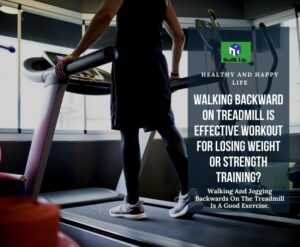There are several advantages to walking backward on the treadmill (or even sprinting backward, if you are able). Not only will it help you tone different muscles, but it will also help you improve your overall coordination and balance. It even has the added benefit of increasing your heart rate, making it a terrific interval exercise variant.
If you participate in sports, research has discovered that running backwards can minimize your chance of injury while simultaneously improving your performance.

Improved capacity to shift directions more securely is achieved by increasing the power and strength in the lower body.
If you like to find best treadmill for small space, you can find it here.
How To Begin Walking Backwards On A Treadmill?
For those who are unfamiliar with the concept of walking backward on a treadmill, a slow speed is recommended. You may realize that even walking around with your back to the wall is a significant task. Furthermore, as you become more familiar with the material, you can raise your speed in subsequent sessions.
Many treadmills feature a relatively sluggish beginning speed of 0.5 mph, which is standard for the industry. Begin walking at the slowest feasible speed to establish a strong walking posture and rhythm. Once you’ve become used to the pace and are able to maintain it, gradually raise the speed in 0.5 mph increments.
It is probable that muscles that are not as evident during forward walking may begin to work when you increase the speed of your movement. Included in this category are your quadriceps (the muscle on the front of your upper leg) and your calves (the muscle on the back of your lower legs).
Because of this, keep your backward intervals short when you first start. When first starting out, it’s better to simply modify one of the two variables: time or pace. That is, increase intensity by either walking faster or for a longer period of time, but don’t change both at the same time. This allows you to just have to make one adjustment at a time to one changing variable.
Is It Necessary To Use Handrails When Walking Backward?
At the very least, make use of them at first. Walking backwards with your hands off of the side rails should only be attempted once you are confident in your ability to keep your balance on your feet. Going backward necessitates a greater demand on your postural muscles in order to maintain your body straight. You run the danger of falling if these aren’t sturdy enough.
During backward walking or running, your legs, hips, and the muscles that govern your ankles must all work harder in order to maintain a synchronized action. So, if you sense a weakness in any of these that might cause you to fall, continue to rely on the handrails for assistance.
Start by gradually weaning yourself away from utilizing the handrails during your front-facing treadmill exercises if you have been reliant on them even when going ahead. Begin with walking with only one hand on the railing, then go to removing the other as well.
After you have mastered the ability to walk forward without relying on your hands for support, you may begin working on your rear-facing treadmill routine. Start using the railings, then with only one hand, and finally without using the handrails altogether.

Including Walking Intervals In The Reverse Direction.
It is not necessary to spend a significant amount of time walking backward to enjoy the advantages. Try to add backward intervals in your present treadmill program only once or twice over the whole training session, rather than many times throughout. Additionally, just walk backwards for a minute or two at a time.
Because of this, you may wish to stop the treadmill before turning around to walk backward and then stop it again before turning around to walk forward. When you are moving yourself, it is beneficial to use the handrails to maintain your balance.
Walking Backwards While Climbing Inclines.
When walking backward on a treadmill, you may also freshen up your routine by adjusting the inclination of the treadmill. Start slowly, just like you would with speed, by first inclining the treadmill to its lowest setting. When you do this, you will most likely experience a burning sensation in your thighs.
As you gain strength and become more comfortable, you may increase the incline as well as the speed of your walk. Just make sure not to boost them both at the same time, since this might throw you off your game. Do one thing first, and then the other. This provides you with the chance to back down if the pressure becomes too intense.
In addition, you may incorporate incline walking into your backward walking interval routine. Do one minute at a given inclination, then raise the ante for the following minute before dropping the incline back to the starting point. This allows you to increase your calorie burn and muscular strength in a shorter length of time than otherwise.
Another alternative is to shift your body’s position from time to time. Walking backwards with an elevation causes your center of gravity to be lowered, resulting in you being in a half squat position. Maintain a straight back and resist the urge to lean forward. This will increase the amount of energy that is available to your quadriceps muscles. However, if you have knee problems, you should limit this exercise to 30-60 seconds and avoid it altogether.
Running On The Treadmill In The Reverse Direction.

It’s possible that once you’ve become acclimated to the backward motion, you’ll be ready to try backward running on a treadmill for a while. Through your program, alternate times of backward jogging with intervals of forward walking (or slow jogging) for a few minutes at a time, as needed.
If you discover that it’s difficult to maintain your balance, slow down until you find a comfortable rhythm. As your body becomes more acclimated, you may raise the speed, which will also increase the intensity. Once you’ve become used to it, you might want to experiment with some inclines.
Running or jogging backwards on the treadmill might offer some variety to your existing treadmill regimen. If you’re having fun and reaping the advantages of your workouts, it may be easier to continue with them over the long haul, according to the experts. This also translates into long-term benefits.
